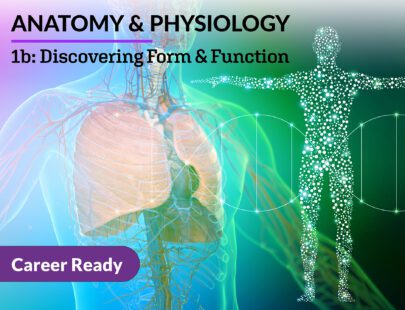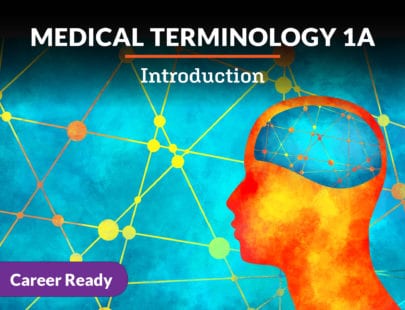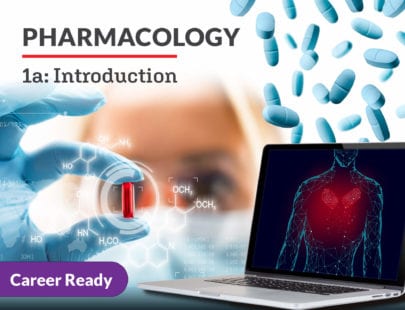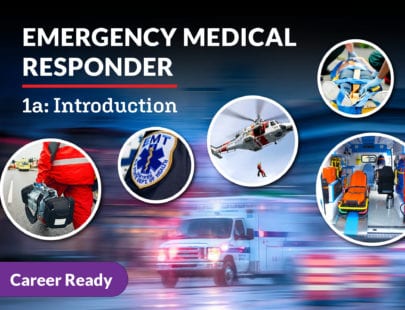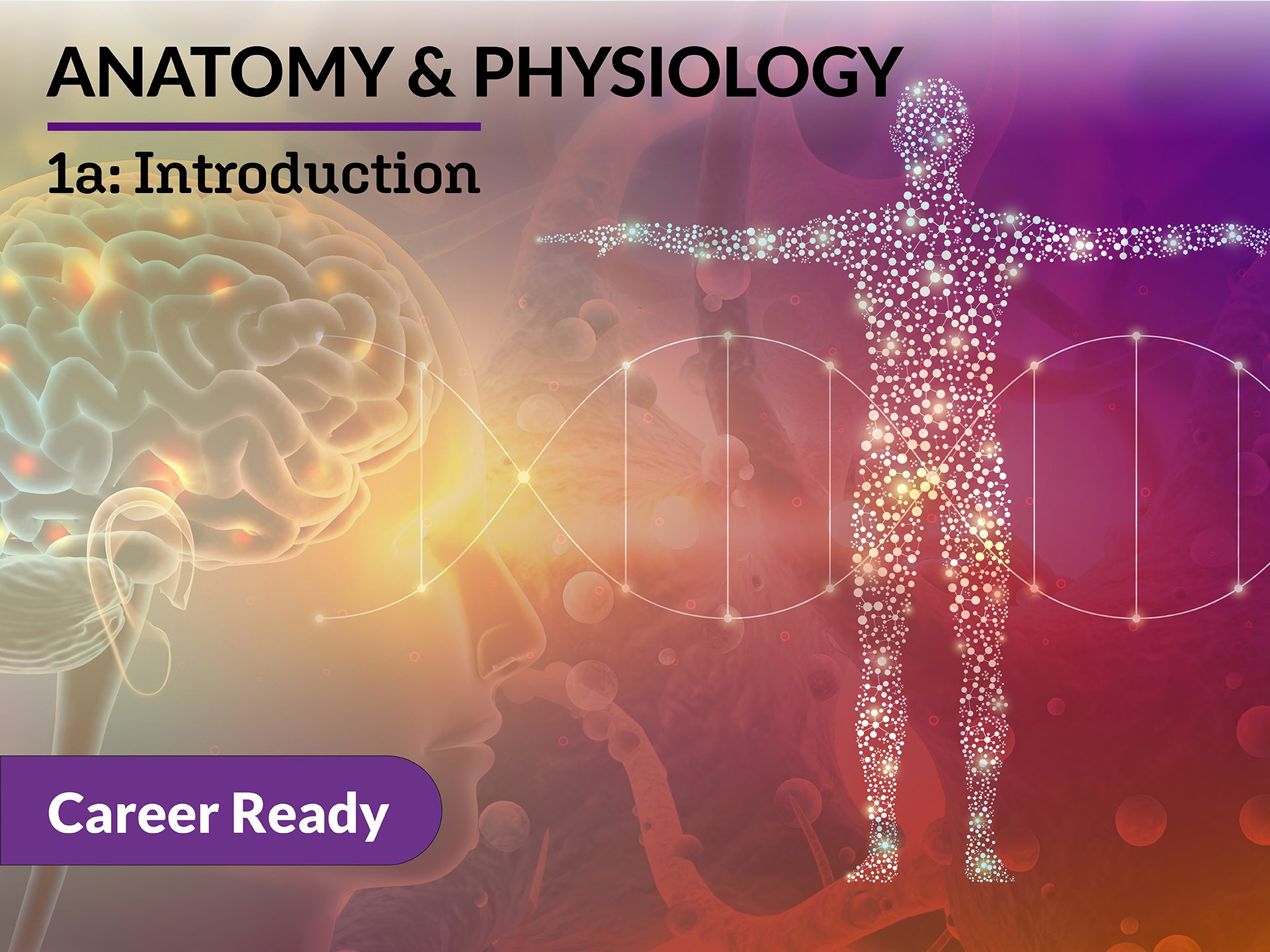
Anatomy and Physiology 1a: Introduction
Thinking about a career in health, but not sure where to start? You’re in the right place! Anatomy and physiology is the study of the body structures and how they function. From the tiniest molecule to the largest organ, a fascinating journey occurs. In this course, you will explore the organization of the human body, including the integumentary, skeletal, muscular, nervous, and endocrine systems and their common conditions. You will also learn to speak the language of medicine and how to apply laboratory skills. And along the way, you’ll discover the many exciting career paths available to you – anatomy and physiology is the perfect place to get started!
Units at a Glance
Unit 1: Foundations of Medicine
Welcome to your journey into the human body! Although you are heading on a symbolic journey instead of hopping on a bus or a plane, there are some similarities between these two adventures. If you were embarking on a trip to Paris, you would want to know a little about the language and how to get around. Maybe you’d memorize how to say “please” and “thank you” in French and read up on how to ride the Métro so you could ensure a more pleasant trip. In the same way, as you begin your journey in the health science career pathway, you’ll want to know the history, language, and how-tos of medicine. You’ll also be introduced scientific processes that you will use in this course and beyond. Let’s begin!
What will you learn in this unit?
- Describe the history of the study of anatomy and physiology.
- Interpret and communicate common medical terminology and medical abbreviations.
- Explain the nature of science and apply its methods.
- Collect and organize data, including measurements using the SI system of units.
- Analyze and interpret data from investigations to form conclusions.
Unit 2: Organization and Maintenance Mechanisms
Being human is hard work. Every day, you need to eat food to nourish yourself and drink enough water to stay healthy. You need to get enough sleep to function at school. You need to go to the bathroom and eliminate waste when nature calls. Not to mention, approximately 22,000 times a day you have to breathe! Let’s get into the “why” behind the phenomena we experience in our bodies. We’ll break down what it means to be a living thing, examine how our body processes help us to stay alive, and identify how the body is organized. We’ll explore the things we can’t even see to understand what we experience as humans and gain an even greater appreciation for our amazing (and high-maintenance) bodies!
What will you learn in this unit?
- Identify and apply the principles of the cell theory and recognize the common characteristics that all living things, including humans, share
- Explain the structures and primary functions of the four major categories of biological macromolecules and their relationship to cellular function in the human body
- Define tissue and compare the composition and purpose of different types of tissue found in the human body
- Describe the significance of the organ, organ system, and organism levels of organization as well as the interdependence of the levels of organization in maintaining homeostasis
- Utilize appropriate directional terminology when referring to the human body, including directional terms, planes, body cavities, and body quadrants
Unit 3: The Integumentary System
At first glance, your skin may appear to be a fairly simple and thin layer covering your body. However, there is so much more to your skin than meets the eye! Skin is part of the integumentary system, which makes up 6-9 lbs. (3-4 kg) of total body weight. Your hair, eyelashes, eyebrows, skin, fingernails, and toenails are all part of this vital system that helps you interact with the outside world. We spend a lot of time caring for it and protecting it, and in this unit, we’ll discover how the integumentary system in turn protects us.
What will you learn in this unit?
- Identify the structures of the integumentary system, including labeling the layers of skin and examining the roles of the four major exocrine glands
- Connect the structures of the integumentary system to their functions, including the role of the integumentary system in maintaining homeostasis
- Analyze the factors that contribute to skin color, scar formation, and skin features such as freckles and moles
- Describe the origin, treatment, and prevention of common diseases and disorders of the integumentary system
Unit 4: The Skeletal System
Quick, look around. there’s a skeleton in your room! You may not be surprised by this fact because that skeleton is actually inside of YOU. Unlike a Halloween decoration, your skeleton is truly alive. Your skeletal system is growing and changing, just like the rest of your organ systems. Here, we’ll journey through the skeletal system and find out all of the amazing things the skeletal system does to (literally) keep you together. We’ll learn about how bones grow, identify the different types of bones, and discover what happens when things go wrong with the skeletal system. Let’s bone up on our knowledge of our amazing bones!
What will you learn in this unit?
- Describe the anatomy and histology of bone tissue and the processes of bone growth and repair
- Describe the primary functions of the skeletal system and its role in homeostasis
- Compare and contrast the major bones of the axial and appendicular skeletons
- Classify the types of joints and describe the movements of synovial joints
- Distinguish between the scientific method and the engineering design process
Unit 5: The Muscular System
Your alarm goes off, and your eyelids flicker open as you reach for your phone. Time to get up! You slide out of bed and yawn as your feet hit the floor, then stretch your arms up and head toward the kitchen for breakfast. In just those first few seconds of your day, your muscular system has already done so much! From the swipe of your phone alarm to the opening of your eyes and mouth to the stepping of your feet, your muscles are hard at work. Every movement in your body is made by your muscular system, both the ones you control, such as walking, and those you don’t, such as your heart beating. Here, we’ll explore how your muscles function to keep you alive and moving.
What will you learn in this unit?
- Compare the three muscle types and identify the common characteristics and functions of muscle tissue
- Identify and describe the actions of the major skeletal muscles
- Explain the coordination of muscles, bones, and joints that allows for movement of the body
- Examine the microscopic structure and function of muscle fibers
- Distinguish between types of muscular system injuries and recognize how to treat them
Unit 6: The Nervous System
Have you ever stepped on something sharp with bare feet? OUCH! That sensation will make you jump before you realize what is happening, and you may be left rubbing your foot (and looking for the younger sibling who left their toys on the floor). Pain signals can travel as fast as 270 miles per hour (435 kilometers per hour) through your body’s nervous system to help you respond quickly and avoid harm. However, the nervous system does more than protect you from errant toys; it keeps you alive through the millions of chemical and electrical signals it sends each second. Even as you sleep, this intricate and delicate system is hard at work, doing everything from sustaining your breathing to storing your memories from the day. Here, we’ll discover how the nervous system functions and begin to appreciate its complexity and power.
What will you learn in this unit?
- Compare and contrast the divisions of the nervous system
- Categorize the types of nerve cells and their structures and functions
- Explain the physiology of nerve impulse generation and transmission
- Describe the structure and function of the brain and spinal cord
- Identify the causes, symptoms, and treatments of various nervous system conditions
Unit 7: The Sense Organs
Dinner’s ready! How do you know? Maybe you see that the clock reads 6:15 or you hear the sound of someone calling you to set the table. Perhaps you can smell fresh garlic or feel the warmth of the kitchen. You can thank your senses for this experience of your environment. Here we’ll explore the anatomy of these incredible organs and the physiology of how they integrate with your nervous system to create your understanding of the world.
What will you learn in this unit?
- Distinguish between the special and general senses and explain their relationship to the nervous system
- Relate the structure of the eye to its function in vision
- Identify causes and treatments of several diseases and disorders of the eye
- Describe the process of hearing using the anatomy of the ear
- Identify the role of chemoreceptors and the interrelationship of taste and smell
- Distinguish between the receptors associated with various types of touch, temperature, and pain in the skin
Unit 8: The Endocrine System
Below the level of your consciousness and undetectable to the naked eye, the tiny messengers of your endocrine system are hard at work. While the nervous system sends rapid messages throughout the body, the endocrine system takes its time, sending chemical messages that control everything from your metabolism to your heart rate, height, and sexual development. Because these chemicals reach every cell in the body, endocrine system disorders can have widespread and dramatic effects. Here, we’ll explore the physiology of the hidden yet powerful endocrine system.
What will you learn in this unit?
- Identify the structures and major physiological functions of the endocrine system
- Compare positive and negative feedback loops and methods of endocrine system control
- Explain the connection between the hypothalamus and pituitary gland and their functions in regulating the endocrine system
- Distinguish the roles and major hormones of the thyroid, parathyroid, and adrenal glands
- Describe the role of the pancreas in maintaining blood glucose levels
Required Materials
Physical
- 3% hydrogen peroxide solution
- A graduated cylinder or small liquid measuring tool such as a tablespoon
- Art supplies
- Black or blue ink pen
- Blue food coloring
- Boiling water (1–2 cups or 200–500 mL)
- Clean paperclip
- Clothespin
- Cotton swab
- Five pieces of clear glassware
- Knife or scalpel
- Laboratory notebook
- Medium-sized potato
- Metric ruler with millimeter markings
- Paper hole reinforcer
- Paper towel
- Safety glasses
- Scientific journal
- Small cup of water
- Standard bound composition notebook (approximately 80-100 pages)
- Tape/pen or dry-erase marker
- Three tabs for dividing pages (you may use sticky notes, tape, or store-bought tabs)
- Timing device
- Various household items
- Video recording device
- Vinegar (acetic acid solution)
- Writing materials
Software
- Presentation software
- Word processing software
Other
- Helper
- Test subjects (5-10 people)
Optional
- Audio recording device
- Baking soda
- Calculator
- Camera
- Chicken or beef liver
- Digital camera
- Flashlight
- Forceps or a caliper
- Glass stirring rod or metal spoon
- Graph paper
- Graphic design software
- Highlighter
- Image editing software
- Magnifying glass
- Online citation tool (such as Scribbr)
- Spreadsheet software
- Sticky notes or flags
- Video editing software
- Warm water
